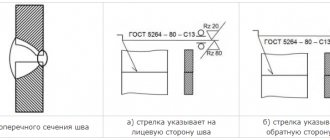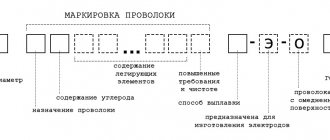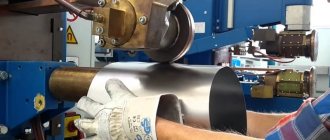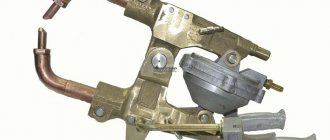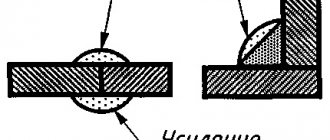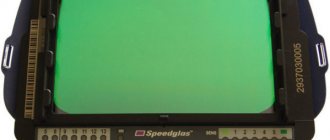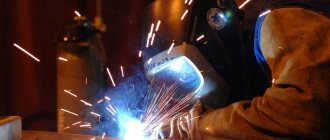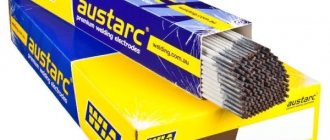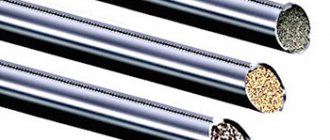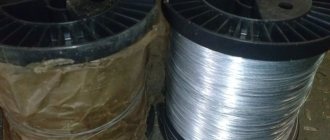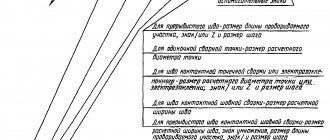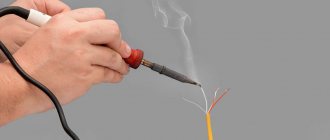What the article is about:
Designation system for MIG/MAG, TIG and MMA welding
If earlier manual arc welding was designated simply and clearly (RDS), then today the designation system has changed. Especially when it comes to abbreviations such as TIG, MMA and MIG/MAG.
In order not to get confused by them, you need to understand what type of welding we are talking about in this or that case.
This article will look at the modern designation system: what MIG/MAG is, as well as what TIG and MMA welding are.
Designation system MIG/MAG, TIG and MMA
In the Soviet Union, manual arc welding was designated as RDS. This type of welding occupies a leading position in the industry. Manual arc welding is also actively used in everyday life, as the simplest and most reliable method of welding metals.
Today's designation for manual arc welding is MMA - Manual Metal Arc. This type of welding involves the use of an electric arc and coated stick electrodes. Electrodes can have a basic or rutile coating, but it must be present on the metal rod.
For some reason, many people confuse MMA welding with a consumable electrode with a coating with TIG welding. Electrodes are also used for TIG welding, but only without coating. Non-consumable electrodes are made of tungsten, and they do not provide any protection for the weld pool, but serve only to form the future seam.
TIG welding uses inert gases and tungsten electrodes. It is worth noting that in some countries, for example, in Germany, this type of welding is designated somewhat differently, namely WIG (Wolfram Inert Gas).
Also, you can often find another designation for welding with non-consumable electrodes, for example, GTA (Gas Tungsten Arc). In this case, in addition to inert gases (helium, argon or nitrogen), a welding arc operating from alternating and direct current also acts as the formation of a welding arc.
Advantages and disadvantages
Any technological process has strengths and weaknesses. Advantages of argon TIG welding:
- Thanks to the use of protective gas, the seam is uniform, without pores, cracks, or voids. Argon protects the heated surface from the oxide film formed when hot metal interacts with oxygen.
- Internal stresses generated during welding without shielding gas are reduced.
- Metal does not splash.
- After welding, the products do not require additional processing.
- TIG welding can be used to join most known metals and alloys.
- It is enough to try to operate the equipment 2-3 times to master the skill of creating high-quality, beautiful seams.
Disadvantages of TIG welding:
- When using equipment outdoors, the connection point must be protected from the wind. Air flows disrupt the direction of movement of the protective gas, deteriorating the quality of the seam.
- It is necessary to carefully prepare the work surface.
- You cannot select an acute angle of inclination of the torch relative to the workpiece. This complicates the workflow.
- At the place where the electric arc ignites, a mark remains that will need to be cleaned off.
Considering the shortcomings of TIG equipment, you can prepare for possible difficulties during welding operation.
Beautiful weld seams
What does MIG/MAG welding mean?
MIG/MAG - denotes exclusively semi-automatic wire welding in a protective gas environment. That is, if different types of electrodes are used for MMA and TIG welding, then only wire is used for MIG and MAG welding.
In this case, MIG welding is performed in an inert gas environment, and MAG welding is performed in an active gas environment. This is actually their main difference. You can read more about MIG and MAG welding on the website.
Semi-automatic welding is widely used in production. This is the second type of welding after manual arc welding, which is actively used today throughout the world.
The characteristic properties of semi-automatic welding are a smooth and beautiful welding seam without slag. Semi-automatic welding, simply irreplaceable when repairing cars and other equipment.
It also has another designation - GMA (Gas Metal Arc).
Rules for the certification of welders - Classification of welding work
Contents of the material
3. Classification of welding work and symbols for certification of welders
3.1. Certification of welders is carried out separately for each type of work in accordance with the requirements regarding the quality of welded joints provided for by the Rules of the State Supervision Service for Labor Supervision, State Safety Inspectorate or other regulatory documentation. 3.2. When certifying, it is necessary to take into account the following characteristics of welded joints: - welding method; — type of seam, type and conditions of welded joint; — group of materials to be welded; — type and dimensions of welded parts; — welding position. 3.2.1. Certification is carried out separately for each of these welding methods (the conventional digital designation of welding methods corresponds to ISO 4063-78): - manual arc welding with a covered electrode (RSE) - 111 - arc welding with flux-cored wire (SP) - 114 - submerged arc welding with a wire electrode (SF) - 121 - arc welding with a metal (fusible) electrode in inert gases (MIG) - 131 - arc welding with a metal (fusible) electrode in active gases (MAG) - 135 - arc welding with flux-cored wire with active gas protection (PAG) - 136 - arc welding with flux-cored wire in inert gases (PIG) - 137 - arc welding with a tungsten electrode in inert gases with or without filler wire (TIG) - 141 - plasma welding (PS) - 15 - gas welding (GS) - 311
3.2.2. During certification, the type of weld, type and conditions of the welded joint should be taken into account:
butt weld - BW fillet weld - FW single-sided welded joint - ss double-sided welded joint - bs with backing - mb without backing - nb with root stripping - gg without root stripping - ng with filler material - wm without filler material - nm
3.2.3. To reduce technically equivalent checks, welded materials that have similar metallurgical and welding-technological characteristics are combined into groups shown in Table 1, and welders are certified for permission to weld a certain group of materials. When testing welded joints from any one material of a group, the welder is granted the right to weld all other materials that are included in this group. Table 1 Groups of welded steels
Type and characteristics of welded materials
Carbon and low-alloy steels with a guaranteed yield limit at normal temperature of 360 MPa (generally, do not require heating during welding)
Chrome-molybdenum and/or chrome-molybdenum-vanadium steels (mainly require preheating, and control of heat input and heat treatment after welding)
Normalized improved fine-grain steels and thermomechanically processed steels with a normal temperature yield limit greater than 360 MPa, as well as similarly weldable steels with a nickel content of 2 to 5% (generally require preheating and/or heat input control)
Steels of ferritic, martensitic and martensitic-ferritic classes, which contain from 12 to 20% chromium
High-alloy chromium-nickel steels of feritic-austenitic and austenitic classes
Note. Group indices comply with the European standard EN 287-1.
Welding of control joints is carried out using filler material similar in composition to the base material. If the base material is welded using a filler material that differs in composition from the base material, then the group is established according to the composition of the weld material. When welding materials that belong to different groups, the welder is certified according to the group of materials with the highest number, provided that this is provided for in clause 6.3. If these groups are not included in tables 6 and 7 of paragraph 6.3, then a separate test is required for such a connection. When welding clad (two-layer) steels, a group is established for the main and clad layers, and certification is carried out separately for each group of materials. 3.2.4. Welding of control joints is carried out using one of the filler materials provided for by the Rules of the State Supervision Service for Welding and Safety of Labor or GSN for welding materials of this group. Certification carried out using a specific filler material that is suitable for the group of a given base metal gives the welder the right to use the remaining filler materials of this group. When welding with coated electrodes, the spread area should be taken into account depending on the type of electrode coating. 3.2.5. Control welded joints are made using plates (P) and pipes (T). Plate welding qualification tests are carried out separately for the thickness (t) ranges specified in Table 2. Pipe welding qualification tests are carried out separately for the diameter (D) and wall thickness (t) ranges specified in Tables 2 and 3.
Work as a welder using method 136/135 in Poland
In search of a better life and more favorable working conditions, many specialists from Ukraine have already chosen to work abroad. Workers in various fields are valued abroad, because Ukrainian job seekers are famous for their hard work and high quality of work.
Electrician is one of the in-demand technical professions. Specialists in this industry are indispensable in the modern world. Craftsmen are required not only for equipping residential buildings, but also industrial premises.
Poland offers promising prospects for professionals. And it’s not just about high wages, but also about opportunities for career and personal growth, advanced training, as well as the manifestation and application of one’s own knowledge and skills.
Welding training - Process - 111/135/136/131
Language of instruction: Russian, English
A welder connects (welds) elements of metal structures, pipelines, machine parts and mechanisms using a welding machine. Assembles workpieces (assemblies) of structures, sets up welding equipment, sets the required welding mode, and carries out visual inspection of seams. Prevents the occurrence of stress and deformation in the product.
Basic requirements for an employee (health, personal qualities, psychological qualities, etc.) Physical strength and endurance, sharp vision and good light perception, a good sense of balance, the ability to concentrate for a long time, good hand-eye coordination, spatial imagination and technical thinking, accuracy and equilibrium. The profession is contraindicated for people suffering from the following diseases:
Respiratory organs; musculoskeletal system (sciatica, osteochondrosis, etc.); cardiovascular and nervous systems; mental disorders and having severe visual and hearing defects.
Requirements for a candidate
1. Special education in the field of welding 2. Age at least 18 years
3. Work experience of at least 3 years
Purpose of training: To prepare them for independent passing for the International Certificate
Will know: -physical and chemical properties of ferrous and non-ferrous metals, methods of their connection depending on the size of the parts; - design, principles and operating modes of welding machines; -properties of electrodes and methods of their selection for various grades of metals being welded; -rules for preparing parts and assemblies for welding; -reasons for the occurrence of internal stresses and deformations in welded products;
-technical requirements for the quality of welded joints, measures to prevent defects and ways to eliminate them.
Will be able to: - correctly select the desired welding mode; -perform welding in various ways, in various spatial positions; -weld parts of various configurations and sizes; - weld shells and other defects in knots and linings; -carry out surfacing of worn parts;
-acceptance of welded joints.
Upon completion, the following is issued: 1. A certificate of the established form 2. Upon successful passing of the exam, an International Welding Certificate in accordance with EN ISO 9606-1.
Valdkond: Tehnika,tootmine and töötlemine
Kutseala: Metalli töötlemine ja metalltoode tootmine
Eriala: Keevitajate ettevalmistamine ja atesteerimine-MMA/MIG/MAG /TIG keevitaja
Koolitusprogrammi vastab: EVS EN ISO 9606-1
Standard
moodul N.TeemaTeooriaPraktikaÕpetajaHindamine
| 1 | Testimine Sertifikaatsioonile ettevalmistuse tase kontrollSertifikaatsiooniala määramine | 2 | 2 | Sergei Boaga Andrei Boaga | Arvestus |
| Materjaliteadus, keevitusmaterjalid, materjalide ettevalmistamine keevituse jaoks | 2 | 2 | Andrei Boaga Vjatseslav Gorohhov | ||
| Keevitajate sertifikaatsioon vastavalt EVS EN ISO 9606-1 | 2 | Sergei Boaga Andrei Boaga | |||
| Keevisõmbluste kvaliteedile nõuded EVS EN ISO 5817 | 2 | 2 | Sergei Boaga | ||
| Praktilise eksamile ettevalmistus | 18 | Andrew Boaga | |||
| 2 | Eksam EVS EN ISO 9606-1 | 1 | 8 | Sergei Boaga Andrei BoagaVjatseslav Gorohhov | Eksam |
| Kokku | 8 | 32 | 40 ak.t |
- Sergei Boaga
- Qualification: 1.International Welding Technologist, 2.EN ISO 9712 Inspektor VT-2,PT-2 3.International Welding Inspection PersonnelStaff *C*(comprehensive)
- Qualification: International Welding Engener
- Qualification: 1.International Welding Specialist,2.EN ISO 9712 Inspektor VT-2
Assessment
Moodul 1
The student knows the topics of the module and can apply them in practice. It is necessary to complete a practical task and demonstrate your practical skills necessary to pass the international certificate in accordance with the EVS EN ISO 9606-1 standard. Assessment: personal conversation with the teacher and completion of a practical assignment.
Pass/fail
Moodul 2
The student performs a practical task on one or more welding processes, according to the EVS EN ISO 9606-1 standard. Pass/fail
The training is considered complete provided that the student successfully passes the test and exam.
We offer optimal course durations, convenient class schedules and affordable
cost of training to become a welder.
- Course duration: 40-80 academic hours
- Frequency of classes: 6 times a week
- Duration of classes: 8 academic hours
- Document of completion: 1. Certificate of established form
Source: https://westweld.eu/2016-10-08-16-13-26/kursy/podgotovka-i-sertifikatsiya-svarshchikov
Resume “Welder (MIG/MAG 135, 136, TIG 141:311)”
Summary dated 14 June 2018
Full employment, partial employment, distance work.
Century: 48 years Place: Kiev
Shukach put in his phone number and ate. I'll send it to the address.
You can access the contact details of your resume on the page https://www.work.ua/resumes/522588/
from 04.2013 to 12.2017 (4 months 8 months) Hansa-Flex, Kyiv (Hansa-Flex LLC is the official representative of Hansa-Flex Hydraulik (Germany), which is known in the world as a leading manufacturer of high-pressure hoses (HPR))
Manufacturing of metal hoses (bellows) Welding of aluminum and non-ferrous metals method 136, 135, 141,311 Soldering Welding of muffler corrugations.
Welder method 136, 135, 141
from 09.2005 to 01.2013 (7 days 4 months) “Volodimir LTD”, Kyiv (food and commercial equipment)
argon welder 5th grade
argon welder
from 09.2004 to 07.2005 (10 months) LLC “Energoservice”, Fastov (Installation and adjustment of gas pumping equipment)
installation and commissioning: argon welder
Welder method 130, 135, 141
from 08.2002 to 08.2004 (2 rocks) ZAT “Panna”, Kyiv (Architecture and design)
argon welder
DHTT
Junior specialist electrician, Dneprodzerzhynsk Serednya special, from 08.1995 to 05.1998 (2 days 9 months)
“Installation and operation of electrical equipment of enterprises and civil buildings”
PTU-4
Berdichev Serednya, from 09.1985 to 09.1988 (3 rocks)
electric welder 3rd category
Dodatkova osvita
VAT "Fakel" LLC "Training plant "Slavutich" (2010)
Professional and other skills
- Beginners with computers I understand a little (:-) Confident user, we train
- I have all my own welding equipment. (20 rokіv dosvidu) Stuck in, vikorist at this hour.
